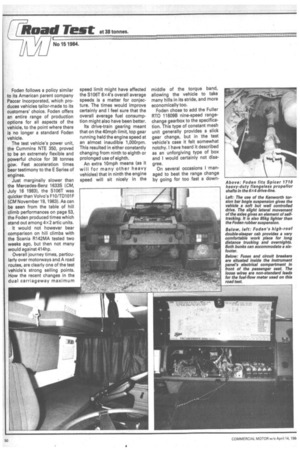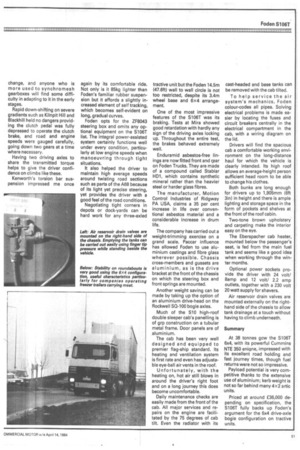Foden convinces
Page 51

Page 52

Page 53

If you've noticed an error in this article please click here to report it so we can fix it.
The worth of the 6x4 tractive unit was strongly demonstrated by the performance of the 6106T. Journey times and road holding both impressed Bryan Jarvis
WITH THE first year of operating at 38 tonnes almost completed, many fleet operators are becoming concerned about trailer kingpin loading difficulties and are looking more Intently at the wide selection of three-axled tractive units.
While the majority of heavy manufacturers have come out in favour of the 6 x 2 axle configuration, Foden firmly believes that its MT 6 x 4 unit not only overcomes weight distribution problems but also offers a much higher trailer kingpin loading tolerance.
Whatever the argument, at 38 tonnes gcw the three-axied tractive units certainly overcome many of the inherent dangers of drive-axle overloading, and also give very good stability and
handling characteristics.
Driving the S108T over the demanding Scottish route, with the Crane Fruehauf tandem-axled test trailer, I was certainly impressed by the marked difference in stability on roundabouts and tight curves between this axle arrangement and the more conventional 4x2 tractive unit and tri-axle trailer.
I knew of the widely held view that this axle configuration has a tendency to understeer on bends, but I was not troubled during the test. On the contrary, the vehicle handled extremely well, particularly on the severe section between Jedburgh and Consett.
Providing that the power available is used sensibly when driving out of curves, particularly at lower road speeds, any understeer is kept to an absolute minimum.
A badly placed vehicle in Shotley Bridge prevented me from making the usual sharp right angled return to the Blackhill climb. Instead I had to carry out an almost full u-turn at the road junction further down.
At the tightest part of the turn, the excessive tyre scrub normally experienced when manoeuvring at low road speeds with a tri-axle trailer, transmitted itself to the Foden's twin drive axles. The extra power needed to overcome the scrub also produced a tramping effect causing the vehicle to follow the bogie's track and not the steered line.
Foden follows a policy similar to its American parent company Paccar Incorporated, which produces vehicles tailor-made to its customers' choice, Foden offers an entire range of production options for all aspects of the vehicle, to the point where there is no longer a standard Foden vehicle.
The test vehicle's power unit, the Cummins NTE 350, proved to be an extremely flexible and powerful choice for 38 tonnes gcw. Fast acceleration times bear testimony to the E Series of engines.
Just marginally slower than the Mercedes-Benz 1633S (CM, July 16 1983), the S106T was quicker than Volvo's Fl 0/TD101F (CM November 19, 1983). As can be seen from the table of hill climb performances on page 53, the Foden produced times which stand out among 4x2 artic units.
It would not however bear comparison on hill climbs with the Scania R142MA tested two weeks ago, but then not many would against 414hp.
Overall journey times, particularly over motorways and A road routes, are clearly one of the test vehicle's strong selling points. How the recent changes in the dual carriageway maximum speed limit might have affected the S106T 6x4's overall average speeds is a matter for conjecture. The times would improve certainly and I feel sure that the overall average fuel consumption might also have been better.
Its drive-train gearing meant that on the 40mph limit, top gear running held the engine speed at an almost inaudible 1,000rpm. This resulted in either constantly changing from ninth to eighth or prolonged use of eighth.
An extra 10mph means (as it will for many other heavy vehicles) that in ninth the engine speed will sit nicely in the middle of the torque band, allowing the vehicle to take many hills in its stride, and more economically too.
Foden chose to add the Fuller RTO 11609B nine-speed rangechange gearbox to the specification. This type of constant mesh unit generally provides a slick gear change, but in the test vehicle's case it felt somewhat notchy. I have heard it described as an unforgiving type of box and I would certainly not disagree.
On several occasions I managed to beat the range change by going for too fast a down change, and anyone who is more used to synchromesh gearboxes will find some difficulty in adapting to it in the early stages.
Rapid down-shifting on severe gradients such as Kilnpit Hill and Blackhill held no dangers providing the clutch pedal was fully depressed to operate the clutch brake, and road and engine speeds were gauged carefully, going down two gears at a time where necessary.
Having two driving axles to share the transmitted torque helps to give the driver confidence on climbs like these.
Kenworth's torsion bar suspension impressed me once again by its comfortable ride. Not only is it 85kg lighter than Foden's familiar rubber suspension but it affords a slightly increased element of self tracking, which becomes self-evident on long, gradual curves.
Foden opts for the ZF8043 steering box and omits any optional equipment on the S106T list. The integral power-assisted system certainly functions well under every condition, particularly at low engine speeds when manoeuvring through tight situations.
It also helped the driver to maintain high average speeds around twisting road sections such as parts of the A68 because of its light yet precise steering, yet provides the driver with a good feel of the road conditions.
Negotiating tight corners in depots or dock-yards can be hard work for any three-axled tractive unit but the Foden 14.5m (47.6ft) wall to wall circle is not too restricted, despite its 3.4m wheel base and 6x4 arrangement.
One of the most impressive features of the S106T was its braking. Tests at Mira showed good retardation with hardly any sign of the driving axles locking up. Throughout the entire test, the brakes behaved extremely well.
Enduramid asbestos-free linings are now fitted front and ilear on Foden Trucks. They are made of a compound called Stabler HD1, which contains synthetic mineral rather than the heavier steel or harder glass fibres.
The manufacturer, Motion Control Industries of Ridgway PA USA, claims a 35 per cent increase in life over conventional asbestos material and a considerable increase in drum life.
The company has carried out a weight-trimming exercise on a grand scale. Paccar influence has allowed Foden to use aluminium castings and fibre glass wherever possible. Chassis cross-members and gussets are aluminium, as is the drive bracket at the front of the chassis on which the steering box and front springs are mounted.
Another weight saving can be made by taking up the option of an aluminium drive-head on the Rockwell SCI-100 bogie axles.
Much of the S10 high-roof double sleeper cab's panelling is of grp construction on a tubular metal frame. Door panels are of aluminium.
The cab has been very well designed and equipped to premier flag-ship standard. Its heating and ventilation system is first rate and even has adjustable eye-ball air vents in the roof.
Unfortunately, with the heating on, hot air still blows in around the driver's right foot and on a long journey this does become uncomfortable.
Daily maintenance checks are easily made from the front of the cab. All major services and repairs on the engine are facilitated by the 75 degrees of cab tilt. Even the radiator with its cast-headed and base tanks can be removed with the cab tilted.
To help service the air system's mechanics, Foden colour-codes all pipes. Solving electrical problems is made easier by locating the fuses and circuit breakers centrally in the electrical compartment in the cab, with a wiring diagram on the lid.
Drivers will find the spacious cab a comfortable working envi ronment on the long-distance haul for which the vehicle is clearly intended. Its high roof allows an average-height person sufficient head room to be able to change his clothes.
Both bunks are long enough for drivers up to 1,905mm (6ft 3in) in height and there is ample lighting and storage space in the form of pockets and shelves at the front of the roof cabin.
Two-tone brown upholstery and carpeting make the interior easy on the eye.
The Eberspacher cab heater, mounted below the passenger's seat, is fed from the main fuel tank and seems like a good idea when working through the winter months.
Optional power sockets provide the driver with 24 volt/ 8amp and 12 volt/ 2.2 amp outlets, together with a 230 volt 20 watt supply for shavers.
Air reservoir drain valves are mounted externally on the right hand side of the chassis to allow tank drainage at a touch without having to climb underneath.
Summary At 38 tonnes gcw the S106T 6x4, with its powerful Cummins NTE 350 enigne, impressed with its excellent road holding and fast journey times, though fuel returns were not so impressive.
Payload potential is very competitive thanks to the extensive use of aluminium; kerb weight is not so far behind many 4 x 2 artic units.
Priced at around 06,000 depending on specification, the S106T fully backs up Foden's argument for the 6x4 drive-axle bogie configuration on tractive units.




























































































